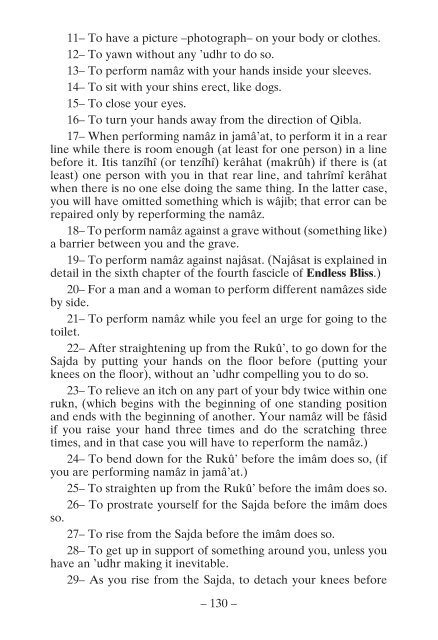Miftah-ul-Janna (Booklet for way to Paradise)
You also want an ePaper? Increase the reach of your titles
YUMPU automatically turns print PDFs into web optimized ePapers that Google loves.
11– To have a picture –pho<strong>to</strong>graph– on your body or clothes.<br />
12– To yawn without any ’udhr <strong>to</strong> do so.<br />
13– To per<strong>for</strong>m namâz with your hands inside your sleeves.<br />
14– To sit with your shins erect, like dogs.<br />
15– To close your eyes.<br />
16– To turn your hands a<strong>way</strong> from the direction of Qibla.<br />
17– When per<strong>for</strong>ming namâz in jamâ’at, <strong>to</strong> per<strong>for</strong>m it in a rear<br />
line while there is room enough (at least <strong>for</strong> one person) in a line<br />
be<strong>for</strong>e it. Itis tanzîhî (or tenzîhî) kerâhat (makrûh) if there is (at<br />
least) one person with you in that rear line, and tahrîmî kerâhat<br />
when there is no one else doing the same thing. In the latter case,<br />
you will have omitted something which is wâjib; that error can be<br />
repaired only by reper<strong>for</strong>ming the namâz.<br />
18– To per<strong>for</strong>m namâz against a grave without (something like)<br />
a barrier between you and the grave.<br />
19– To per<strong>for</strong>m namâz against najâsat. (Najâsat is explained in<br />
detail in the sixth chapter of the fourth fascicle of Endless Bliss.)<br />
20– For a man and a woman <strong>to</strong> per<strong>for</strong>m different namâzes side<br />
by side.<br />
21– To per<strong>for</strong>m namâz while you feel an urge <strong>for</strong> going <strong>to</strong> the<br />
<strong>to</strong>ilet.<br />
22– After straightening up from the Rukû’, <strong>to</strong> go down <strong>for</strong> the<br />
Sajda by putting your hands on the floor be<strong>for</strong>e (putting your<br />
knees on the floor), without an ’udhr compelling you <strong>to</strong> do so.<br />
23– To relieve an itch on any part of your bdy twice within one<br />
rukn, (which begins with the beginning of one standing position<br />
and ends with the beginning of another. Your namâz will be fâsid<br />
if you raise your hand three times and do the scratching three<br />
times, and in that case you will have <strong>to</strong> reper<strong>for</strong>m the namâz.)<br />
24– To bend down <strong>for</strong> the Rukû’ be<strong>for</strong>e the imâm does so, (if<br />
you are per<strong>for</strong>ming namâz in jamâ’at.)<br />
25– To straighten up from the Rukû’ be<strong>for</strong>e the imâm does so.<br />
26– To prostrate yourself <strong>for</strong> the Sajda be<strong>for</strong>e the imâm does<br />
so.<br />
27– To rise from the Sajda be<strong>for</strong>e the imâm does so.<br />
28– To get up in support of something around you, unless you<br />
have an ’udhr making it inevitable.<br />
29– As you rise from the Sajda, <strong>to</strong> detach your knees be<strong>for</strong>e<br />
– 130 –

















